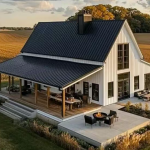Moblie: 8613816755915
Difference between prefab home and light gauge steel frame house
In recent years, the development of building technology has led to the emergence of new production and construction methods. There is a growing trend towards seeking cost-effective and efficient housing solutions. Two such methods that have become popular in recent years are prefab homes and light gauge steel framed houses. These two construction methods have revolutionized the way houses are built, making the process faster, more efficient and more cost-effective. However, despite the similarities between these two methods, there are still some differences, and Solidhome will discuss both differences in detail to help buyers understand both methods better.
Define
Prefab Home
Prefab homes are built in a factory and then transported to the construction site. They are also known as modular homes, as they consist of multiple modules or sections that are built separately and then assembled on-site. This process allows for faster construction and reduced labor costs.
Light gauge steel frame houses
Light gauge steel frame houses, also known as LGS or cold-formed steel houses, are a relatively new form of construction. As the name suggests, these houses are primarily built using light-gauge steel as the main structural element. these houses have frames made of thin steel sheets that are rolled and bent into different profiles before being bolted together to create a rigid frame.
Difference
Strength and Durability
Overall, Light gauge steel frame houses, are stronger and more durable than prefab homes.
Light Gauge Steel Frame House are made of high-strength galvanized thin steel, which can withstand high loads and natural disasters such as wind and snow based on the raw material. Galvanized steel is more resistant to external corrosion and has a very long service life. prefab homes are made of steel, wood and other materials that are not as strong or durable as steel. Therefore, many of the prefab homes are used as temporary housing, or the life of the house; while the light steel frame houses are permanent housing service life of more than 50 years.
Speed of construction
Prefab homes are built in a factory and shipped to the site to be used straight away or just put together and ready to use, and one of Solidhome’s folding prefab homes can be assembled in just six hours. This makes the construction process faster and allows homeowners to enjoy their home quickly. Light gauge steel frame houses, on the other hand, although most of the components are processed in the factory, are significantly slower than prefab homes due to the large number of components, which are still heavily bolted or welded on site. Even though some large frames can be assembled in the factory, the installation of walls, windows, and doors need to be done on-site, making the construction speed significantly slower than prefab homes.
Design Flexibility
The design flexibility of prefab homes and light gauge steel frame houses also differs. Prefab homes are limited to the dimensions of the modules or panels, which can impact the overall design of the house. Each of Solidhome’s prefab homes is individually styled, and if a customer needs to customize a new design, it needs to be re-designed and re-produced, which takes a lot of time and costs a lot more.
This is not the case with Light gauge steel frame houses as they can be built into any shape and size. For the designer, it is simply a matter of making changes to the function and shape of the building, which only need to be designed and constructed for external effect. The lightweight steel itself can be built in all shapes and sizes.
Costs
To tell you the truth, you may not believe it, depending on the different classifications of prefab houses, there are high and low costs with Light gauge steel frame houses. For example, if you choose Flat Pack Container House, the cost is much lower than Light gauge steel frame houses. (Flat Pack Container Houses are mostly temporary homes.) If you compare the cost of a panelized home to a Light gauge steel frame house, then a panelized house may be more expensive.
Of course, this is just a product comparison, and there is a portion of cost that needs to be considered. Light gauge steel frame houses have much higher labor costs than prefabricated homes, which is obvious in areas where labor is high. Therefore, Solidhome’s Light gauge steel frame houses have their frames and even walls prefabricated in factories as much as possible, which reduces on-site construction time and labor costs.
The above briefly describes how Light gauge steel frame houses compare to prefabricated homes, and ultimately, homeowners should carefully consider their needs and preferences to determine which option is best for them.


